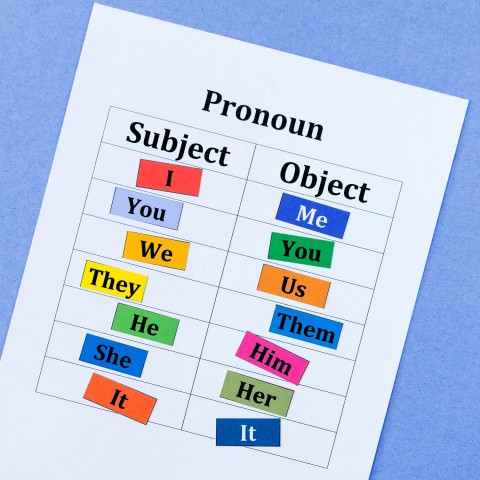
Let me look into my magic crystal ball and tell you what I see… You’re interested in learning Turkish or have just started working on it. You’re curious to know what Turkish grammar looks like and whether it’s similar to English grammar. And actually, you’re dying to learn what kind of an adventure you’re getting yourself into.
Of course, I’m not a fortune teller. But if I guessed correctly, you’re at the right address. This page serves as an overview of Turkish, an essential grammar guide, and a quick reference for those who want to brush up on specific grammar topics.
Our quick guide will show you the similarities and dissimilarities between Turkish and English as well as the basic structure of Turkish grammar, from vowel harmony to conjugation.
Let’s get started.
 Table of Contents
Table of Contents
- General Overview
- Word Order
- Word Structure and Agglutination
- Suffixes, Vowel Harmony, and Buffers
- Possessives
- Verbs and Conjugation
- Access More Turkish Grammar Content on TurkishClass101.com
1. General Overview
Before we get into the details, it’s important that we cover the basic Turkish grammar rules and how they compare to those you’re familiar with in English.
Similarities
First of all, both languages use the Latin alphabet. The Turkish alphabet, however, consists of 29 letters, 6 of which don’t exist in English ( -ç, -ğ, -ı, -ö, -ş, -ü). There are also 3 letters in English (-q, -w, -x) that don’t exist in the Turkish alphabet.
There are a few words that exist in both Turkish and English that have the same meaning:
- ➢ TV
➢ Plan
➢ Program
➢ Market
➢ Silo
➢ Video
Like English, Turkish also uses the indefinite article in front of nouns as a separate word:
- ➢ Bir araba (“A car”)
➢ Bir otel (“A hotel”)
In addition, neither Turkish nor English uses grammatical gender for objects.
It’s safe to say that there are no accent marks in English, since the words that have them are taken from other languages. There are no accent marks in Turkish, either.
However, the circumflex is used for some loanwords. It affects the pronunciation of a word by implying that the word’s pronunciation should be longer or that there should be palletization of the consonant that comes before the vowel.
For example: “Âmâ” is an Arabic word that means “blind.” The circumflex here makes both of the “a” sounds longer. There’s another word, “ama,” which means “but.” Although they are spelled the same way (except for the circumflex), those two words are pronounced differently.
Dissimilarities
Now let’s take a look at the features of Turkish grammar that differ from English.
Pronouns
There’s just one word used in Turkish for “he,” “she,” and “it,” which is o.
In Turkish, the plural “you” is not only used as it is in English, but also as a polite, formal way of addressing someone. The same set of rules apply to both the plural “you” and the polite “you” in Turkish.
The Definite Article
Turkish has no definite article (“the”) as a separate word. When definite nouns or pronouns are used as an object, then they take the “-ı, -i, -u, -ü” suffixes based on the vowel harmony rules. Let me give you an example:
- ➢ Anahtarlar çantamın içinde. (“The keys are in my purse.”)
Here, “keys” is used without an article.
- ➢ Anahtarları çantamın içine koydum. (“I put the keys in my purse.”)
Here, “keys” takes the suffix -ı to indicate the definite article.
Numbers as Adjectives
When numbers are used as adjectives to count nouns, the noun does not become plural based on the number. Rather, it stays in the singular form. Here’s an example:
- ➢ Bir elma (“One apple”)
➢ Beş elma (“Five apples”)
Word Order
The Turkish word order is Subject-Object-Verb. This topic will be covered in more detail later.
Vowel Harmony and Suffixes
Vowel harmony is another feature that doesn’t exist in English. You can see the details about this in the “Suffixes, Vowel Harmony, and Buffers” section of this page.
Conjugations
The conjugation in Turkish is much different from that in English, which we’ll discuss in more detail later on in the “Verbs and Conjugation” section. But to give you an example, there’s a tense called “reported past tense,” which doesn’t exist in most languages.
2. Word Order
In Turkish grammar, word order typically follows the SOV (Subject-Object-Verb) structure. In other words, the sentence begins with the subject, which is followed by the object (if any), and then the verb.
However, this is not a strict rule and there’s some flexibility, meaning that you can put an object or a verb at the beginning of a sentence. Doing so won’t change the meaning of the sentence, but the word you’re emphasizing will definitely change.
The word that you want to stress should be placed as close to the verb as possible, and if you want to emphasize the verb, then you should place it at the beginning of the sentence.
| Subject-Object-Verb | Ben okulumu seviyorum. | “I love my school.” |
| Object-Subject-Verb | Okulumu ben seviyorum. | “I love my school.” |
| Object-Verb-Subject | Okulumu seviyorum ben. | “I love my school.” |
| Verb-Subject-Object | Seviyorum ben okulumu. | “I love my school.” |
All of the sentences above have the same meaning, but the emphasis is on the words highlighted in blue.
- → Also see our article A Journey into the Turkish Word Order for more detailed information on how this aspect of Turkish grammar works!

3. Word Structure and Agglutination
In Turkish grammar, suffixes and vowel harmony play a huge role in how words are formed and used. In this section, we’ll introduce you to word structure and agglutination in Turkish.
Structure of Words
In the structure of a Turkish word, a vowel always follows a consonant and a consonant always follows a vowel:
- ➢ bebek (“baby”)
➢ araba (“car”)
Therefore, if you see a word where one consonant follows another, you can tell that it’s a loanword:
- ➢ pratik (“practical”)
➢ armut (“pear”)
In order to keep the “vowel + consonant” rule, buffers are used. Those buffers are “y, n, s.”
You can see some relevant examples of this in our section on vowel harmony and buffers.

Agglutination of Words
Turkish is called an agglutinative language, meaning that new words are formed by adding suffixes to the root words. To give you an idea, a suffix can be added to a noun to 1) make it another noun, or 2) turn it into a verb. It can also be added to a verb to make it a noun or another verb.
Are you confused? Here are some examples to help you understand these Turkish suffix rules better:
- ➢ Yolcu (Noun) – “Passenger”
Yolcu+luk = Yolculuk (Noun) – “Trip”
- ➢ Göz (Noun) – “Eye”
Göz+le = Gözle (Verb) – “Observe,” “Monitor”
- ➢ Bil (Verb) – “Know”
Bil+mece = Bilmece (Noun) – “Puzzle”
- ➢ Kal (Verb) – “Stay”
Kal+dır = Kaldır (Verb) – “Lift,” “Remove”
4. Suffixes, Vowel Harmony, and Buffers
People who want to learn Turkish grammar and vocabulary usually think that these characteristics are really interesting, probably because they don’t exist in most other languages. I wonder if you’ll agree with them!
That said, these are some of the most important Turkish language grammar rules, so pay attention.
Vowel Harmony
In Turkish, words are structured so that vowels follow a certain pattern, and this pattern is called vowel harmony. It’s used to determine which vowel will be used when adding a suffix to a word. Here’s a table showing the vowel types:
| FRONT | BACK | |||
| UNROUNDED | ROUNDED | UNROUNDED | ROUNDED | |
| OPEN | -e | -ö | -a | -o |
| CLOSED | -i | -ü | -ı | -u |
And here are the vowel harmony rules:
- Back vowels follow back vowels and front vowels follow front vowels.
- Unrounded vowels follow unrounded vowels.
- A rounded vowel can be followed by a mix of rounded closed and unrounded open vowels.
Suffixes
Let’s see when suffixes are added:
- Suffixes are based on the person/subject that a verb alludes to.
- Suffixes are used when the subject is plural.
- Suffixes are used based on the tenses.
- Suffixes are used if there is negativity.
- Suffixes are used if interrogative particles will be used.
- Suffixes are used when passive, reflexive, causative, or a verb of mutual action will be formed.
- When definite nouns or pronouns are used as an object, then they take the “-ı, -i, -u, -ü” suffixes, based on the vowel harmony rules.
- Suffixes are used when using possessive pronouns, since there are no separate words for them in Turkish. The suffixes “-m, -ım, -im, -um, -üm” (in conjugated forms) come after the pronoun to make it possessive.
- Suffixes are used when motion towards an object (to), motion from an object (from), and static location (on, at) is to be specified.
It’s a great thing to be able to use the right suffix! However, you also need to make sure that you choose the right vowels for those suffixes based on the vowel harmony.
Buffers
As mentioned earlier, there are three buffers (y, n, s). These are used to maintain the “vowel + consonant” rule when adding suffixes.
- Usage of “y“:
- Used with an accusative suffix
Example: Silgi+y+i = Silgiyi (“The eraser”) - Used with dative. (Movement towards something)
Example: Parti+y+e = Partiye (“To the party”)
- Used with an accusative suffix
- Usage of “n“:
- Used with genitive case [Ownership]
Example: Ayna+n+ın = Aynanın (“The mirror’s”)
Aynası+n+ın = Aynasının (“His/her/its mirror”) - Used for nouns that already have suffixes
Example: Boya+lar+ı+n+a = Boyalarına (“To their paints”)
Oda+sı+n+dan = Odasından (“From his/her/its room”)
- Used with genitive case [Ownership]
- Usage of “s“:
- Only used with the third person suffixes (-ı, -i, -u, -ü)
Example: Elma+s+ı = Elması (“His/her/its apple”)
- Only used with the third person suffixes (-ı, -i, -u, -ü)
5. Possessives
In Turkish grammar, possessives are formed much differently from how English speakers are used to. In this section, we’ll cover two topics: how to form possessive pronouns and how to use the possessive (genitive) case.
Possessive Pronouns
In the Turkish language, there aren’t separate words that stand for possessive pronouns. However, suffixes (-m, -ım, -im, -um, -üm), in conjugated forms, come after a pronoun to make it possessive. Let’s take a look at a couple of examples:
- ➢ Sen+in = Senin (“Your”)
➢ Biz+im = Bizim (“Our”)
Possessive pronouns can be omitted because the nouns they are modifying also take suffixes, which imply the possessive pronoun. However, if you want to stress the possessive pronoun, then you can use it in the sentence. Here are some examples:
- ➢ Benim valizim çok küçük. (“My suitcase is very small.”)
Valizim çok küçük. (“My suitcase is very small.”)
- ➢ Sizin aileniz nerede? (“Where is your family?”)
Aileniz nerede? (“Where is your family?”)
Possessive (Genitive) Case
In the possessive case, both the “possessor” and “possessed” are suffixed. Here are a couple of examples:
- ➢ Araba+nın anahtar+ı (“The car’s key”)
➢ Elbise+nin düğme+si (“The button of the dress”)
6. Verbs and Conjugation
The final points we’ll cover today have to do with verbs and conjugation.
- → Because these are such crucial topics, we recommend that you also study our lesson on the Top 20 Turkish Verbs and read our blog post on Turkish verb conjugation.
How to Form Different Types of Verbs
- Passive verbs are formed by adding the affixes -n, -il, or -in. Here are some examples:
Okumak (“To read”)
Oku+n+mak (“To be read”)
Germek (“To stretch”)
Ger+il+mek (“To be stretched”)
Silmek (“To erase”)
Sil+in+mek (“To be erased”)
- Causative verbs are formed by adding the affixes -dir, -t, or -ir. Below are some examples:
Yemek (“To eat”)
Ye+dir+mek (“To make somebody eat”)
Pişirmek (“To cook”)
Pişir+t+mek (“To have something cooked”)
İçmek (“To drink”)
İç+ir+mek (“To make someone drink”)
- Reflexive verbs are formed by adding the -in affix. Here is an example:
Giymek (“To wear clothes”)
Giy+in+mek (“To dress oneself”)
- Verbs of mutual action are formed by adding the -iş affix. For example:
Çarpmak (“To hit”)
Çarp+ış+mak (“To collide”)
Reported Past Tense
I can hear you asking, “Reported tense? What is that?”
You’re absolutely right in asking this question because it’s not a very common tense.

It’s used:
- when the speaker is explaining something that he/she hasn’t witnessed, but heard from someone else
Annem bana hediye almış. (“My mother bought me a gift.”)
[My mother told me she did, but I didn’t see her buying it.]
- when telling a story
Güzel bir kız varmış. (“There was a beautiful girl.”)
[I haven’t seen the girl, it’s just a character in a story.]
- when the speaker is telling someone that he/she (the speaker) has done something without noticing it
Durakta uyumuşum ve otobüsü kaçırmışım. (“I slept at the bus stop and missed the bus.”)
[I didn’t realize I slept and missed the bus.]
Ben kitabı daha önce okumuşum. (“I have read this book before.”)
[I started reading a book, but realized that I read it before and forgot until now.]
- when you’re telling someone about your dream
Rüyamda çok zenginmişim. (“I was very rich in my dream.”)
[It’s like storytelling; you’re telling someone about your dream, which is not reality.]
- when imagining something and telling someone
Mesela, benim iki çocuğum varmış. (“For example, I had two kids.”)
[This is again not reality; you’re imagining that you had two kids.]
Verb Conjugation
In Turkish grammar, verb conjugation is based on the following factors:
- Person / Subject: In Turkish, different suffixes are added to a verb based on the person/subject it alludes to. Vowels in the suffixes change based on the vowel harmony rules.
- Number of Subjects: Whether the subject is singular or plural impacts the suffix that the verb will get.
- Politeness Level: As mentioned above, the plural “you” is also the polite “you” and the same rules are applied to both.
- Tense: Based on the tense, verbs take different suffixes.
7. Access More Turkish Grammar Content on TurkishClass101.com
In this article, we presented you with information on the major topics of Turkish grammar. Which aspects seem the most difficult to you, and why? Let us know in the comments!
Now that you have a better idea of what to expect from the language, you should have little trouble as you continue learning Turkish grammar online with us.
Want to learn Turkish grammar and vocabulary in depth? Bookmark TurkishClass101.com! Take advantage of our numerous audio recordings, vocabulary lists, and free resources—including our Turkish-English dictionary that you can refer to anytime.
Don’t forget that with a Premium PLUS subscription, you can also utilize our MyTeacher service to practice with a private teacher. He or she will work with you one-on-one and provide you with lessons and assignments tailored to your needs and goals, as well as personalized feedback to help you improve.
Best of all, you can learn Turkish anywhere, anytime by downloading the app for free!
Do you have suggestions, comments, or concerns? You can always provide us with feedback about all of the resources provided at TurkishClass101.com!










